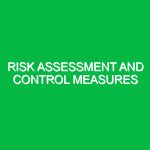Introduction
Safety compliance in manufacturing is a critical component of the Health, Safety, and Environment (HSE) domain. It refers to the adherence to regulations, standards, and organizational policies designed to protect the health and safety of workers while minimizing environmental impacts. In a sector where the stakes are high—often involving heavy machinery, chemical substances, and intricate processes—ensuring safety compliance is not just a legal obligation but a moral imperative.
The relevance of safety compliance extends beyond the confines of regulatory requirements. It fosters a culture of safety that can lead to enhanced employee morale, reduced workplace accidents, and improved operational efficiency. By prioritizing safety, companies can not only comply with laws but also enhance their reputation, reduce costs related to accidents, and increase productivity.
In this article, we will explore the various hazards and risks associated with safety compliance in manufacturing, offer safety precautions and best practices, and outline the key regulations and standards governing this critical area.
Potential Hazards and Risks in Manufacturing
Manufacturing environments are replete with potential hazards that can jeopardize the safety of employees. Understanding these risks is the first step in establishing robust safety compliance measures.
Physical Hazards
Physical hazards are perhaps the most visible in manufacturing settings. They include:
– **Machinery and Equipment**: Heavy machinery can cause serious injuries. For instance, a worker might get caught in a conveyor belt, leading to severe lacerations or amputations. Regular maintenance and proper training are essential to mitigate these risks.
– **Slips, Trips, and Falls**: These incidents account for a significant percentage of workplace injuries. Wet floors, uneven surfaces, and cluttered walkways can all contribute to falls. Implementing proper housekeeping practices can drastically reduce these incidents.
Chemical Hazards
The manufacturing industry often involves handling hazardous materials.
– **Exposure to Toxic Chemicals**: Workers in chemical manufacturing may be exposed to harmful substances that can lead to respiratory issues or skin diseases. For example, a case study from a chemical plant in Ohio revealed that inadequate ventilation led to chronic respiratory problems among employees. Regular training on handling chemicals safely and the use of personal protective equipment (PPE) can mitigate these risks.
– **Fires and Explosions**: Flammable materials pose a significant risk. A notable incident occurred in a manufacturing facility where improper storage of flammable liquids led to an explosion, resulting in injuries and extensive property damage. Implementing strict storage protocols and ensuring proper labeling can help prevent such disasters.
Ergonomic Hazards
Ergonomics plays a crucial role in manufacturing safety. Poorly designed workstations can lead to musculoskeletal disorders. For instance, workers at an assembly line may experience back pain due to repetitive motions and awkward postures. Ergonomic assessments and workstation redesign can alleviate these issues, enhancing comfort and productivity.
Environmental Hazards
Manufacturing processes can have significant environmental implications.
– **Pollution**: Emissions from factories can contribute to air and water pollution. A notable example is a textile manufacturing plant that discharged untreated wastewater, severely impacting local ecosystems. Implementing effective waste management and pollution control measures is essential for compliance and environmental stewardship.
– **Noise**: Prolonged exposure to high noise levels can lead to hearing loss. In a study conducted in a metal fabrication shop, many workers reported hearing difficulties attributed to unregulated noise levels. Noise control measures, such as soundproofing and the use of ear protection, can mitigate these risks.
Best Practices and Precautions for Safety Compliance
Establishing effective safety compliance in manufacturing requires a proactive approach. Here are some best practices to consider:
Risk Assessment and Management
Regular risk assessments are vital. Companies should conduct thorough evaluations of their operations to identify potential hazards. This process should involve employees, as they can provide invaluable insights based on their firsthand experiences. Once risks are identified, businesses can implement appropriate control measures, prioritizing risks based on their potential impact.
Training and Education
Investing in employee training is crucial for fostering a safe work environment. Workers should receive comprehensive training on safety protocols, emergency procedures, and the proper use of PPE. A personal anecdote from a safety manager at a manufacturing plant underscored this point: after implementing regular safety drills, the facility saw a 50% reduction in workplace incidents. Continuous education keeps safety at the forefront of employees’ minds.
Personal Protective Equipment (PPE)
Providing appropriate PPE is non-negotiable. Depending on the nature of the work, this may include helmets, gloves, goggles, and respiratory protection. Regular inspections of PPE and ensuring employees are trained in their proper use can significantly enhance safety.
Safety Culture and Communication
Encouraging a culture of safety is fundamental. Companies should foster open communication regarding safety concerns. Employees should feel empowered to report hazards without fear of retaliation. Regular safety meetings create a platform for discussing challenges and sharing solutions.
Emergency Preparedness
Manufacturing facilities must have robust emergency preparedness plans in place. This includes fire drills, evacuation routes, and first-aid training. A case study from a food processing facility highlighted the importance of preparedness; after a fire broke out, the swift action of trained employees saved lives and minimized damage.
Regulations and Standards Governing Safety Compliance
Various regulations and standards govern safety compliance in manufacturing, ensuring organizations maintain a safe working environment. Here are some of the key regulations:
Occupational Safety and Health Administration (OSHA)
OSHA is the primary federal agency responsible for enforcing workplace safety regulations in the United States. It sets forth standards that manufacturers must follow, covering everything from machine safety to hazardous materials handling. Compliance with OSHA regulations is essential for mitigating risks.
Environmental Protection Agency (EPA)
The EPA enforces regulations related to environmental safety. Manufacturers must comply with standards concerning waste disposal, emissions, and pollution control. Meeting these standards not only protects the environment but also enhances the company’s reputation.
American National Standards Institute (ANSI)
ANSI develops consensus standards for various industries, including manufacturing. These standards provide guidelines for equipment safety, ergonomics, and other critical aspects of workplace safety.
Conclusion
Safety compliance in manufacturing is a multifaceted endeavor that encompasses a range of practices, regulations, and cultural elements. By understanding the potential hazards and implementing best practices, organizations can foster a safer work environment that not only meets legal obligations but also protects their most valuable asset—their employees.
In an industry where the margin for error is slim, prioritizing safety compliance is not just good practice; it is essential for sustainable success. As manufacturers continue to evolve, so too must their commitment to health, safety, and environmental stewardship. The journey towards safety compliance is ongoing, but with dedication and proactive measures, it is a journey worth undertaking.


